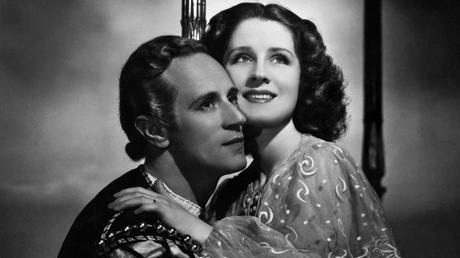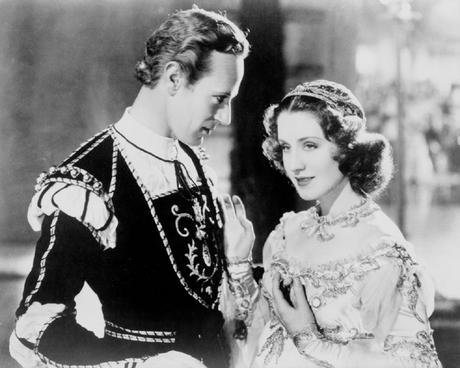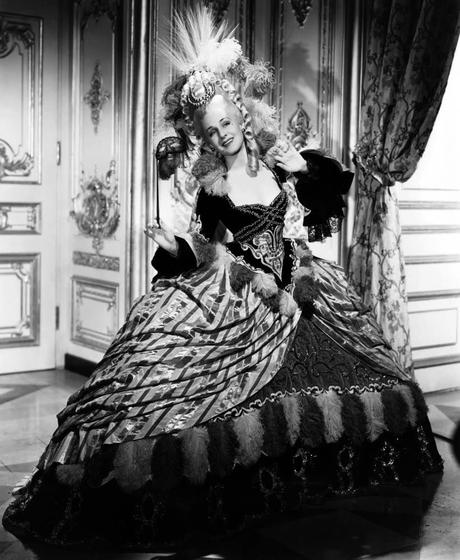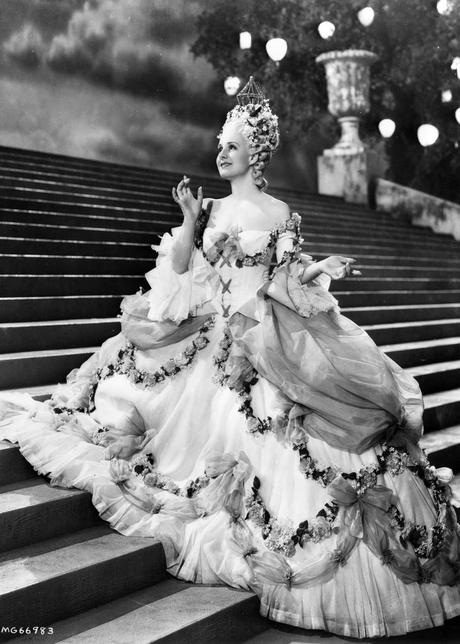
When talking about the career of Norma Shearer, it’s impossible to not discuss the career of Irving Thalberg. Being married to one of the most celebrated producers in Hollywood meant that her career became very closely intertwined with his, particularly throughout the 1930s.
During the 1920s, Norma Shearer worked her way up to become one of the biggest stars at Metro Goldwyn Mayer. After starring in movies with other luminaries of the silent film era like John Gilbert, Ramon Novarro, and Lon Chaney, she transitioned well into talkies and won an Academy Award for her performance in 1930’s The Divorcee. With her 1927 marriage to Irving Thalberg, they had become one of the biggest power couples in Hollywood. Thalberg was often accused of only caring about Norma’s films, but I’ve never thought that was a fair assessment of his career. However, he did work to help her have the career of her dreams.
By the mid-1930s, Norma’s career had hit a crossroads. With production codes being fully enforced, she was no longer able to play the sophisticated, liberated women she exemplified in the pre-Code era and, under Thalberg’s guidance, she entered the “prestige picture” era of her career. Years later, when television entered the mainstream, the films she made during this time were the ones she would become most closely associated with for several decades, not her pre-Code work.
Of all the movies made during this phase of her career, 1936’s Romeo and Juliet is unquestionably one of the two that best reflects her status as the queen of MGM. As if a Shakespeare production didn’t carry enough prestige on its own, it was a truly lavish production. And it’s also the movie the Independent Theater Owners Association was complaining about when they published their Box Office Poison ad in May 1938 and included Norma Shearer on their list of stars they claimed did little to draw people into theaters.

Adaptations of Shakespeare in general were a risky venture for film studios. Even with high potential for artistic achievement, they weren’t an easy sell. When plans were announced for MGM’s adaptation of Romeo and Juliet, the only person who seemed enthused about it was Irving Thalberg. Romeo and Juliet would be the kind of prestige picture that Louis B. Mayer famously despised. Not only would it be expensive to produce, he knew it would lack the widespread appeal necessary for it to be profitable. Other MGM execs agreed. As far as they were concerned, any potential it had to win an Oscar or two wasn’t worth its estimated $1.5 million budget.
Thalberg tried to assemble an A-list cast and crew to make the concept more appealing, but that also proved to be a challenge. George Cukor signed on to direct, but jokes were already being made about the idea of Norma, who was in her 30s and had recently given birth to her second child, playing a teenager. Thalberg knew the right male lead would make or break this movie. When he approached Clark Gable about the project, Gable replied, “I don’t look Shakespeare, I don’t talk Shakespeare, I don’t like Shakespeare, and I won’t do Shakespeare.” Initially, Leslie Howard initially wasn’t interested in doing the movie and Warner Brothers didn’t want to loan him out for it anyway. However, after some reconsideration on Leslie’s part and some loan-out negotiations between Warner Brothers and MGM, Howard ended up in the part of Romeo.
Theater owners at the time had valid reason to roll their eyes about the idea of getting stuck with a Shakespearean adaptation. By the time MGM’s production of Romeo and Juliet was released, it was just over a year after an adaptation of A Midsummer Night’s Dream from Warner Brothers set the worst kind of box office record: a record number of cancellations from theater owners.
The only way Thalberg was able to get the green light to proceed with Romeo and Juliet was by agreeing to cut the budget down to $800,000. However, production costs quickly exceeded that amount to a considerable degree. The initial $1.5 million budget seemed like a quaintly conservative figure compared to its final price tag of nearly $3 million.
The team working on Romeo and Juliet went to great lengths to make a movie that felt as authentic as possible. During pre-production, a crew spent four months in Italy photographing genuine Renaissance-era items and finding as many items as possible to bring back. Not only did the lead actors have highly detailed costumes created for them, extras in crowd scenes did as well. Massive sets were built, including a full-sized balcony. Consultants were brought on to give advice on how to adapt Shakespeare for the screen and to work with actors on their diction.
In addition to the technical costs of producing Romeo and Juliet, problems with the crew made production a drawn out process. John Barrymore, who was was dealing with alcoholism and recently had seen his marriage to Dolores Costello come to an end, wasn’t exactly reliable. Norma, the only actor in the cast without experience as a stage actor, was anxious about her performance. George Cukor struggled to find his footing as a director, which slowed down filming at times.
When shooting on Romeo and Juliet was finally complete, the first test screening was not the resounding success Thalberg had been hoping for. The audience reaction wasn’t bad, but it wasn’t great, either. Over the years, Thalberg had earned a reputation for being able to rescue projects that received negative or indifferent reactions during test screenings. But in the case of Romeo and Juliet, the source material meant there was little he could do to boost its appeal. On other films, he had the option of doing things like ordering rewrites and reshoots to improve them. Even movies based on more contemporary plays and books gave him some leeway. But since Shakespeare is so deeply enmeshed in the collective consciousness, his hands were largely tied.
In spite of all the doubts surrounding the project, Romeo and Juliet actually wasn’t poorly received. Many critics gave it favorable reviews, even if they fell short of being raves. Very often, they admired aspects of the production and Norma’s performance was generally praised. After its premiere, it did reasonably well at the box office and its performance strengthened in subsequent weeks. Schools organized field trips to see it and it started trends inspired by Norma’s costumes and hairstyles in the film. However, given the total cost of production, doing “reasonably well” at the box office wasn’t enough for MGM to break even on it. In the end, it lost $922,000.
For Thalberg, the box office performance of Romeo and Juliet was a personal disappointment. This was a big passion project for him and he knew that Norma wasn’t going to act forever and wanted her to leave a strong legacy. Even when he was fatally ill, he was still asking about box office numbers for Romeo and Juliet. Romeo and Juliet was released very shortly before Thalberg’s death on September 14, 1936, making it the last film of Norma’s that he was able to personally oversee to completion. But before he died, he had put the wheels in motion for her to work on Marie Antoinette.
Perhaps the greatest irony of Irving Thalberg’s career is the fact that he made a name for himself by reining in Erich von Stroheim’s extravagant, spare-no-expense productions, but ended his career with movies like Romeo and Juliet and The Good Earth, both of which were too expensive to be profitable. Had he lived to oversee it, Thalberg’s vision for 1938’s Marie Antoinette had the potential to make von Stroheim’s extravagance look positively understated in comparison.

Irving and Norma had been pushing to make Marie Antoinette happen since 1933 and Thalberg had very big ideas for it. He imagined it filmed in color and, like Romeo and Juliet, wanted it to have larger-than-life sets and and thousands of ornate costumes. Once again, a crew had already been sent to Europe to purchase antiques and take photographs that could be referenced during production. Over 900 wigs had been created for it. By the time of Thalberg’s death, $400,000 had been spent on pre-production, so scrapping the project all together would have been a big waste of money.
In the aftermath of Thalberg’s death, the executives at MGM took some time to figure out what would become of the projects Thalberg had been working on. Many expected that Marie Antoinette would be scrapped without him, but in late 1936, Louis B. Mayer informed Norma that Marie Antoinette would be her next film and work would begin when she was ready to come back. But first, Norma had some issues to resolve with MGM. She was not at all impressed with the way the studio had been handling Thalberg’s legacy.
While on leave after Irving’s death, Norma heard stories about how some of the execs — ones who owed their entire careers to Irving — were trying to diminish his contributions to the studio and take credit for his work. Mayer was also shortchanging Norma by helping himself to the share of Irving’s profits which Norma was owed. This led to Norma making an appearance on a radio show hosted by Louella Parsons for the purpose of publicly calling Mayer out and making it known that she was considering a new studio.
At that point, Norma was still considered a reliable box office draw, so there was incentive for MGM to keep her around aside from generally avoiding the bad publicity of ripping off the widow of the man who helped build the studio. And Mayer knew how much Norma wanted to do Marie Antoinette, so agreements were eventually reached. Norma signed a new contract with MGM and Marie Antoinette was finally happening — even if Mayer wasn’t happy about having to give up those profit shares.
But without Irving around, that meant others at MGM could have more control over production of his final project. The idea of doing Marie Antoinette in color quickly went out the window. Had it been filmed in color, that alone would have added $4 million to the budget. However, Mayer and other MGM execs were still harboring some resentment over their dispute with Norma and conspired to push Sidney Franklin, the first choice to direct Marie Antoinette, out of the job and bring in W.S. Van Dyke, who was famous for filming things quickly.
When Norma heard that Sidney Franklin was out, she simply didn’t have it in her to fight it. She didn’t want to be perceived as being difficult and she found out about it on the first New Year’s Eve she would be spending without Irving. Even though Norma was willing to settle for W.S. Van Dyke, she had learned how to make studio politics work for her and put those skills to work for her once filming began. It was the only way she knew how to make sure the finished product even came close to matching what Irving had in mind. For example, when she thought Van Dyke was rushing through things, she made sure the right people knew and she ended up getting the reshoots she wanted.

Upon its release in July 1938, Marie Antoinette was very well received. Critics and audiences liked it and it earned four Academy Award nominations. Norma earned one last Best Actress nomination for her performance and MGM was able to get the favorable publicity of following through with the late Irving Thalberg’s final prestige picture. But even when filmed in black and white, the high production costs meant that it was a hit with little hope of becoming profitable. It lost $767,000.
Before his death, Irving Thalberg had been expecting Romeo and Juliet and Marie Antoinette to be Norma’s swan songs. He knew Norma wouldn’t be acting forever and wanted her to leave the public eye triumphantly. But when she signed that new contract with MGM, she had a few films left before retirement.
After Marie Antoinette, Norma starred in 1939’s Idiot’s Delight alongside Clark Gable. While not nearly as extravagant as Marie Antoinette or Romeo and Juliet, Idiot’s Delight still has the distinction of being one of the few movies Clark Gable made at MGM which lost money. That same year, she was part of the all-star ensemble cast for The Women, even though she wasn’t thrilled about the role of Mary Haines. Despite the fact that The Women did well at the box office, it was another movie that fell into the category of being too expensive to be profitable. It wouldn’t earn a profit until a re-release later in the 1940s.
Even though The Women was Norma’s last big hit movie, 1940’s Escape was the last film she appeared in which earned a profit. Her final two movies, We Were Dancing and Her Cardboard Lover both also failed to turn a profit and Norma retired from acting in 1942.
